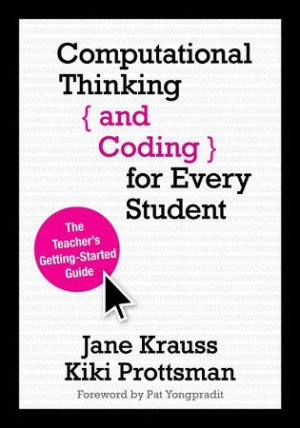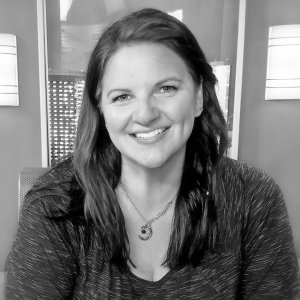Q&A: The Art of Coding
Two educators on how to make learning computer science less daunting and more fun for students—and their teachers.
First impressions matter. That’s equally true whether you’re meeting new people or encountering an unfamiliar subject like computer science. Kiki Prottsman, education director of Code.org, worries that too many students are getting a less-than-inspiring introduction to a field she loves for its creative potential. Instead of having students follow instructions “to write code you’re not interested in and would never use,” she wants them to discover that the thinking involved in computing can be as creative as making art, writing poetry, or directing movies.
Introducing a broader population of K–12 students to computer science also means that more teachers will need to build their own understanding. That’s why Prottsman has teamed up with Jane Krauss, a longtime advocate of project-based learning and equity in the technology sector, to write Computational Thinking {and Coding} for Every Student. The authors made time recently to talk about their efforts to help all students (and teachers) develop fluency in computing.

EDUTOPIA: Your book reads like a conversation. The tone is friendly and approachable. It’s not technical. What do you hope readers will take away?
KIKI PROTTSMAN: Teaching computer science is intimidating for many teachers. Most K–12 teachers didn’t learn this in school, and many of the available resources are written by high-level academics. We wanted to make learning about this more fun, as if you’re talking to a friend.
JANE KRAUSS: In fact, we encourage teachers to read with a buddy. The book is front-loaded with activities that build experience. If you’re teaching computer science to kids, you want to pair up learners. The same goes for adults.
EDUTOPIA: What’s behind current efforts to expand computer science education across the K–12 spectrum? Is this all about workforce development?
KRAUSS: The goal is not to churn out a generation of computer scientists. It’s to put kids on their feet to be self-driving, capable learners who know how to identify and frame problems they want to solve. Computational skills are just one set of tools in their arsenal. They should be able to call on these skills when it makes sense to solve a problem with a computer.
PROTTSMAN: I don’t think people understand how much power and flexibility you have in the 21st century [if you understand computing]. If you want to be an entrepreneur and have basic programming skills, you can visualize what you want, make it happen, and save yourself a lot of money. We aren’t trying to turn everyone into computer engineers or programmers. This is a field where you can think independently, and a computer is helping you check your work.
EDUTOPIA: Your emphasis on the creative side of computer science might surprise people. Tell us more about that.
PROTTSMAN: When I taught introductory courses to college freshmen, I encouraged them to think of computer science as refrigerator poetry. You’re working with a limited set of tools, but what you make with them can be as expressive and original as any poem. Looking at someone’s code is just like looking at a painting or piece of writing. I should be able to look at it and say, “Yes, that came from this person.” It’s the way you use the stuff that makes it art and reflects who you are.
EDUTOPIA: What helps to build teachers’ confidence to give computer science a go in the classroom, even in small ways?

PROTTSMAN: Through Code.org, I’ve done professional development with teachers in many different settings. Many of them come in nervous or hesitant. Some were “voluntold” to come to our workshop. The number one thing that turns them around is doing it themselves. I have them imagine that they are one of their students. Put on the cap of a 10-year-old and really behave like a kid as you go through a lesson. That absolves them of feeling like they have to already know it. They get to go through an experience with childlike eyes. They can ask any questions. That’s been powerful. I’ve never seen anyone who came in terrified who still felt terrified by the end.
KRAUSS: Through the National Center on Women and Information Technology, I work with school counselors to encourage more students to consider technical fields. We give the counselors experiences with coding and computational thinking. They are taking approaches to solving problems that they might not have considered before. They start to use spatial reasoning and learn how to define problems. Then they can look back at their thinking and reflect. It puts you in a new frame, and that’s kind of neat! It helps to have a growth mindset yourself and get over the fear of not being an expert.
EDUTOPIA: In the book, you make distinctions between computational thinking and computer science. How are they related?

KRAUSS: Computer science involves posing a problem in such a way that a computer can help you solve it. Computational thinking encompasses strategies that are important whether you are solving a problem with a computer or without any technology at all. As we explain in the book, solving a sudoku puzzle doesn’t require a computer, but it does involve thinking strategies like decomposition (breaking a problem into smaller parts) and pattern matching. Those are two of the pillars of computational thinking. We also think it’s important that you don’t teach coding in isolation. Having a bigger context is important.
EDUTOPIA: Opportunities are expanding for students to gain exposure to computer science and computational thinking from a young age. Students in South Fayette, Pennsylvania, for example, have experiences with computational thinking from kindergarten all the way through high school. What do you anticipate in the next few years?
KRAUSS: It takes all kinds of minds to solve problems computationally. Efforts to increase equity will make sure everyone’s at the table. Some of the new courses being developed don’t assume prior knowledge with computer science. That should lead to better on ramps for more students. Equity is baked in.
PROTTSMAN: We need to keep the focus on exposing kids to good computer science. If we start requiring it but don’t make sure it’s fun, inspiring, and creative, that could do more harm than good. And even if teachers can only find time to fit in lessons here and there, that can be a start. If kids get inspired and think it’s fun, they can find ways to continue—after school, in clubs, on their own. But first they have to know about it and see how computer science opens endless possibilities.
